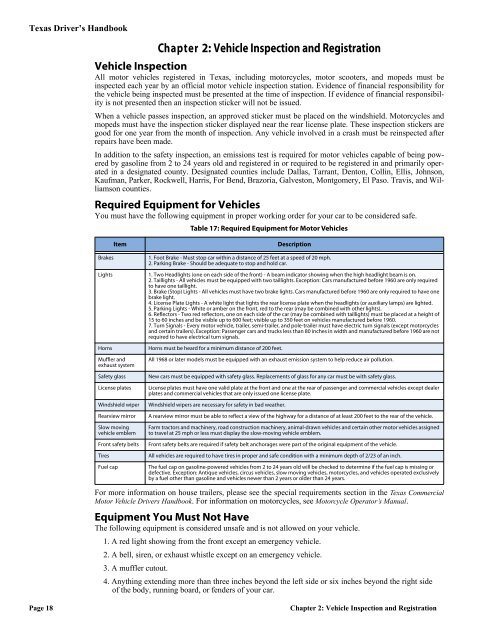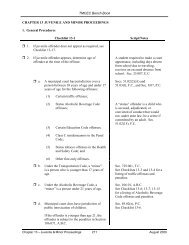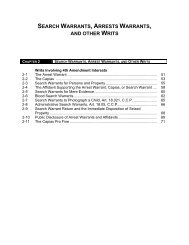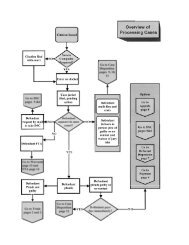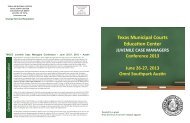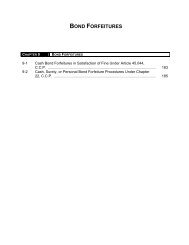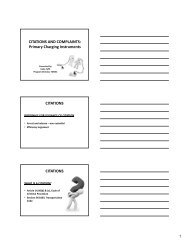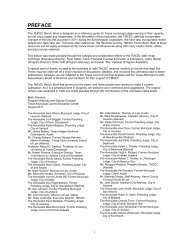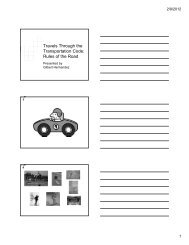Texas Driver's Handbook - National Driver Training Institute
Texas Driver's Handbook - National Driver Training Institute
Texas Driver's Handbook - National Driver Training Institute
Create successful ePaper yourself
Turn your PDF publications into a flip-book with our unique Google optimized e-Paper software.
<strong>Texas</strong> <strong>Driver</strong>’s <strong>Handbook</strong><br />
Chapter 2: Vehicle Inspection and Registration<br />
Vehicle Inspection<br />
All motor vehicles registered in <strong>Texas</strong>, including motorcycles, motor scooters, and mopeds must be<br />
inspected each year by an official motor vehicle inspection station. Evidence of financial responsibility for<br />
the vehicle being inspected must be presented at the time of inspection. If evidence of financial responsibility<br />
is not presented then an inspection sticker will not be issued.<br />
When a vehicle passes inspection, an approved sticker must be placed on the windshield. Motorcycles and<br />
mopeds must have the inspection sticker displayed near the rear license plate. These inspection stickers are<br />
good for one year from the month of inspection. Any vehicle involved in a crash must be reinspected after<br />
repairs have been made.<br />
In addition to the safety inspection, an emissions test is required for motor vehicles capable of being powered<br />
by gasoline from 2 to 24 years old and registered in or required to be registered in and primarily operated<br />
in a designated county. Designated counties include Dallas, Tarrant, Denton, Collin, Ellis, Johnson,<br />
Kaufman, Parker, Rockwell, Harris, For Bend, Brazoria, Galveston, Montgomery, El Paso. Travis, and Williamson<br />
counties.<br />
Required Equipment for Vehicles<br />
You must have the following equipment in proper working order for your car to be considered safe.<br />
Table 17: Required Equipment for Motor Vehicles<br />
Brakes<br />
Lights<br />
Horns<br />
Item<br />
Muffler and<br />
exhaust system<br />
Safety glass<br />
License plates<br />
Windshield wiper<br />
Rearview mirror<br />
Slow moving<br />
vehicle emblem<br />
Front safety belts<br />
Tires<br />
Fuel cap<br />
Description<br />
1. Foot Brake - Must stop car within a distance of 25 feet at a speed of 20 mph.<br />
2. Parking Brake - Should be adequate to stop and hold car.<br />
1. Two Headlights (one on each side of the front) - A beam indicator showing when the high headlight beam is on.<br />
2. Taillights - All vehicles must be equipped with two taillights. Exception: Cars manufactured before 1960 are only required<br />
to have one taillight.<br />
3. Brake (Stop) Lights - All vehicles must have two brake lights. Cars manufactured before 1960 are only required to have one<br />
brake light.<br />
4. License Plate Lights - A white light that lights the rear license plate when the headlights (or auxiliary lamps) are lighted.<br />
5. Parking Lights - White or amber on the front, red to the rear (may be combined with other lights).<br />
6. Reflectors - Two red reflectors, one on each side of the car (may be combined with taillights) must be placed at a height of<br />
15 to 60 inches and be visible up to 600 feet; visible up to 350 feet on vehicles manufactured before 1960.<br />
7. Turn Signals - Every motor vehicle, trailer, semi-trailer, and pole-trailer must have electric turn signals (except motorcycles<br />
and certain trailers). Exception: Passenger cars and trucks less than 80 inches in width and manufactured before 1960 are not<br />
required to have electrical turn signals.<br />
Horns must be heard for a minimum distance of 200 feet.<br />
All 1968 or later models must be equipped with an exhaust emission system to help reduce air pollution.<br />
New cars must be equipped with safety glass. Replacements of glass for any car must be with safety glass.<br />
License plates must have one valid plate at the front and one at the rear of passenger and commercial vehicles except dealer<br />
plates and commercial vehicles that are only issued one license plate.<br />
Windshield wipers are necessary for safety in bad weather.<br />
A rearview mirror must be able to reflect a view of the highway for a distance of at least 200 feet to the rear of the vehicle.<br />
Farm tractors and machinery, road construction machinery, animal-drawn vehicles and certain other motor vehicles assigned<br />
to travel at 25 mph or less must display the slow-moving vehicle emblem.<br />
Front safety belts are required if safety belt anchorages were part of the original equipment of the vehicle.<br />
All vehicles are required to have tires in proper and safe condition with a minimum depth of 2/23 of an inch.<br />
The fuel cap on gasoline-powered vehicles from 2 to 24 years old will be checked to determine if the fuel cap is missing or<br />
defective. Exception: Antique vehicles, circus vehicles, slow moving vehicles, motorcycles, and vehicles operated exclusively<br />
by a fuel other than gasoline and vehicles newer than 2 years or older than 24 years.<br />
For more information on house trailers, please see the special requirements section in the <strong>Texas</strong> Commercial<br />
Motor Vehicle <strong>Driver</strong>s <strong>Handbook</strong>. For information on motorcycles, see Motorcycle Operator’s Manual.<br />
Equipment You Must Not Have<br />
The following equipment is considered unsafe and is not allowed on your vehicle.<br />
1. A red light showing from the front except an emergency vehicle.<br />
2. A bell, siren, or exhaust whistle except on an emergency vehicle.<br />
3. A muffler cutout.<br />
4. Anything extending more than three inches beyond the left side or six inches beyond the right side<br />
of the body, running board, or fenders of your car.<br />
Page 18<br />
Chapter 2: Vehicle Inspection and Registration


